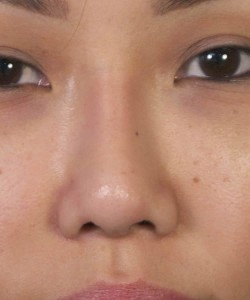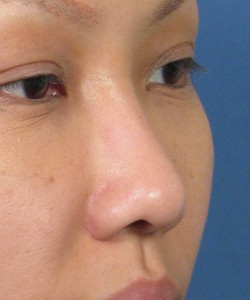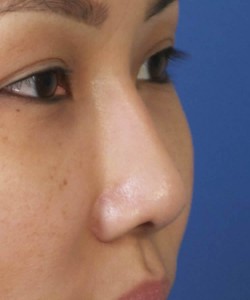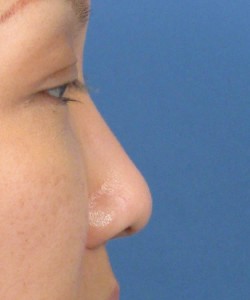Revision Asian rhinoplasty is truly one of the most challenging types of cosmetic nose surgery to perform correctly and should only be attempted by plastic surgeons with dedicated rhinoplasty experience. Primary Asian cosmetic rhinoplasty is a challenge in and of itself. When a rhinoplasty surgeon is faced with revising an Asian nose that has already been operated on by someone else, the complexities of the surgery increase considerably. This is largely because the native cartilage and bone have already been distorted, there is abnormal scar tissue that limits the type of reshaping that can be accomplished and there is usually a relative lack of cartilage remaining for grafting of the nose. These issues are above and beyond the fact the patient is already unhappy with their prior cosmetic result and hesitant about having more surgery performed. I present here a case example of Asian revision rhinoplasty surgery to discuss some of these considerations using a past patient of mine.
Asian Rhinoplasty Presentation
This young Asian lady presented to my office seeking revision cosmetic nose surgery following two prior unsuccessful rhinoplasty procedures performed by another plastic surgeon. Initially, the other surgeon placed an implant in the nose, but it created too much of an artificial look for her desires. The nasal implant was eventually removed by the same surgeon. However, it left her nose close to what she originally had in terms of the bridge height and shape, which was too broad and flat. In addition, the nasal tip reshaping that was performed by this other plastic surgeon left her asymmetrical and more rounded than she desired. After researching Asian rhinoplasty surgeon online, she flew out to my office in San Diego, CA for consultation.
Asian Rhinoplasty Evaluation
One of her main concerns on the frontal view of her nose was a relative lack of definition along the bridge. Typically, this visually translates into poor shadowing along the sides of the bridge. In the Asian rhinoplasty patient population, this finding is commonly seen because the bridge of the nose is too low. In general, any structure that has a low profile will appear somewhat wide when viewed from the front. The same principle applies to a nasal bride that is low in profile – when seen from the front it looks wider in comparison to a nasal bridge that is much higher. For other Asian rhinoplasty patients, the shadowing seen here would be just fine. However, in this particular Asian rhinoplasty patient, her bridge was just too wide for her desires. This partially had to do with the fact she had a prior implant that was placed giving her a more defined bridge. Unfortunately, the implant also gave her an unnatural look to her nose and had to be removed by her previous rhinoplasty surgeon. Because of this, she was seeking to have revision rhinoplasty to create more definition along the entire bridge.
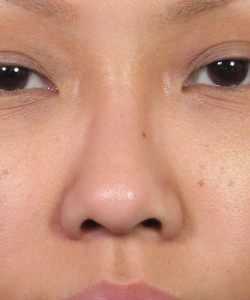 Examination of her nasal tip from the frontal view revealed a fair amount of tip asymmetry – meaning a moderate difference between the right and left sides of her tip. To show you this more visually, I provided a diagrammed photo seen here with a vertical red line drawn essentially in the midline of her face. If you look closely, you can see there is a greater amount of her nasal tip positioned off to her right side. Now keep in mind – everyone is asymmetrical to some degree – even after having had plastic surgery. There is no such thing as the perfect face. But in this particular case, it was more obvious that her nasal tip was displaced to her right side.
Examination of her nasal tip from the frontal view revealed a fair amount of tip asymmetry – meaning a moderate difference between the right and left sides of her tip. To show you this more visually, I provided a diagrammed photo seen here with a vertical red line drawn essentially in the midline of her face. If you look closely, you can see there is a greater amount of her nasal tip positioned off to her right side. Now keep in mind – everyone is asymmetrical to some degree – even after having had plastic surgery. There is no such thing as the perfect face. But in this particular case, it was more obvious that her nasal tip was displaced to her right side.
 In addition, her nasal tip was more rounded than she desired as seen from the frontal view. When considering Asian rhinoplasty surgery, it is important to note that it is completely acceptable (and desirable) to maintain a slightly rounded appearance to the nasal tip region. All too often you see Asian rhinoplasty patients who have had their tip reshaped to the point it appears very artificial and surgical. In many of these cases, the nasal tip has been excessively sculpted and/or narrowed – leaving the patient with a completely unnatural looking nose. In other cases, an L-shaped silicone implant was placed causing the nasal tip to also appear quite unnatural. The goal in Asian rhinoplasty really should be to give the nasal tip more definition while maintaining some degree of convexity around the tip – in essence preserving some of the ethnic Asian features of the nose while making it appear more refined.
In addition, her nasal tip was more rounded than she desired as seen from the frontal view. When considering Asian rhinoplasty surgery, it is important to note that it is completely acceptable (and desirable) to maintain a slightly rounded appearance to the nasal tip region. All too often you see Asian rhinoplasty patients who have had their tip reshaped to the point it appears very artificial and surgical. In many of these cases, the nasal tip has been excessively sculpted and/or narrowed – leaving the patient with a completely unnatural looking nose. In other cases, an L-shaped silicone implant was placed causing the nasal tip to also appear quite unnatural. The goal in Asian rhinoplasty really should be to give the nasal tip more definition while maintaining some degree of convexity around the tip – in essence preserving some of the ethnic Asian features of the nose while making it appear more refined.
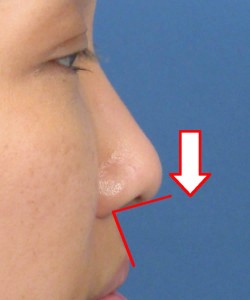 On her lateral view of the nose, the patient also desired slightly more definition. From this perspective this translated into the tip being less rounded as well. But this also included rotating the tip of her nose upward. If you look at the adjacent preoperative lateral view of her nose, you can see that her nasolabial angle is just under 90 degrees. This translates into the tip of the nose appearing as if it droops down too much. Combine this with her tip being more rounded and her overall nose appears less refined. Ideally, in female rhinoplasty patients this angle should be more open. This does not mean her nose should be rotated upward considerably – we are talking about rotating her tip modestly just to create a more feminine contour and shape.
On her lateral view of the nose, the patient also desired slightly more definition. From this perspective this translated into the tip being less rounded as well. But this also included rotating the tip of her nose upward. If you look at the adjacent preoperative lateral view of her nose, you can see that her nasolabial angle is just under 90 degrees. This translates into the tip of the nose appearing as if it droops down too much. Combine this with her tip being more rounded and her overall nose appears less refined. Ideally, in female rhinoplasty patients this angle should be more open. This does not mean her nose should be rotated upward considerably – we are talking about rotating her tip modestly just to create a more feminine contour and shape.
Asian Revision Rhinoplasty Surgery
After consulting with her, we both decided that she was a good candidate to undergo cosmetic revision rhinoplasty. The plan was to re-raise her bridge height while narrowing and rotating the nasal tip. In doing so, the goal was to create a more narrow looking bridge and tip as seen from the front view. The goal was also to create additional nasal tip symmetry so that her nose appeared to sit in a more midline orientation.
The real question going into her revision rhinoplasty procedure had to do with the technique used to re-raise her nasal bridge. This is a maneuver we rhinoplasty surgeons refer to as augmentation of the nasal bridge, or dorsal augmentation. There are many options when it comes to nasal bridge augmentation, which include using the patient’s own cartilage (septum, ear or rib) versus an implant. In most Asian rhinoplasty patients, there is an insufficient amount of septal cartilage to augment the entire bridge. Ear cartilage can be used instead, but usually requires it being wrapped in fascia – a technique called diced cartilage fascia (DCF) grafting. Rib cartilage can also be used, but many patients are not as keen about having a separate incision made along their chest. More detailed discussion of these grafting options can be found here in another of my online rhinoplasty tutorials.
In this particular case, it was decided between the patient and myself that a nasal implant would be the best option for her situation. This was partially based on the fact that she already had a prior silicone nasal implant placed during her first rhinoplasty performed by another plastic surgeon. Therefore, the notion of placing an implant in her nose was not new to her. Unfortunately, the previously used silicone nasal implant was placed such that her nose simply looked too artificial and, thus, it was removed. In my opinion, these silicone nasal implants are commonly associated with an unnatural appearance to the nose, which is why I am not a big proponent of their use in rhinoplasty. Ultimately, we agreed that use of a Goretex nasal implant would be more suitable for dorsal augmentation in her case. Goretex is actually used quite frequently in Asian rhinoplasty surgery as a fairly predictable choice for augmenting the nasal bridge. I much prefer the use of Goretex over silicone as a nasal implant in Asian rhinoplasty as I feel the aesthetic results are better and there is less risk of potential complication in my experience. After thorough discussion, the patient and I decided to proceed with this option in terms of trying to re-elevate her nasal bridge.
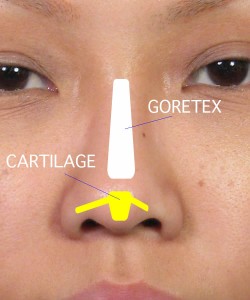 I ended up performing an open revision rhinoplasty to allow me optimal exposure to her nasal tip and bridge. As was planned, her nasal bridge was augmented with a layered Goretex nasal implant. Her nasal tip was then reshaped using a series of septal cartilage grafts. In many Asian rhinoplasty patients, the amount of septal cartilage present is insufficient for grafting purposes. However, in some Asian rhinoplasty patients we are fortunate enough to find an adequate amount of septal cartilage that precludes having to look elsewhere, like the ear. That was the case here where I was able to utilize septal cartilage to reshape her nasal tip. In particular, tip grafting was performed to provide her tip with improved definition while increasing rotation slightly. In this process, additional septal cartilage was placed along the sides of the nasal tip to try and maintain a natural look. Because of how asymmetrical her tip was going into surgery, several maneuvers were also required to try and bring the entire nasal tip more toward the midline. As does happen in some cases of rhinoplasty, a limited revision of her nasal her nasal tip was ultimately performed many months later using a small segment of ear cartilage in order to provide even more symmetry.
I ended up performing an open revision rhinoplasty to allow me optimal exposure to her nasal tip and bridge. As was planned, her nasal bridge was augmented with a layered Goretex nasal implant. Her nasal tip was then reshaped using a series of septal cartilage grafts. In many Asian rhinoplasty patients, the amount of septal cartilage present is insufficient for grafting purposes. However, in some Asian rhinoplasty patients we are fortunate enough to find an adequate amount of septal cartilage that precludes having to look elsewhere, like the ear. That was the case here where I was able to utilize septal cartilage to reshape her nasal tip. In particular, tip grafting was performed to provide her tip with improved definition while increasing rotation slightly. In this process, additional septal cartilage was placed along the sides of the nasal tip to try and maintain a natural look. Because of how asymmetrical her tip was going into surgery, several maneuvers were also required to try and bring the entire nasal tip more toward the midline. As does happen in some cases of rhinoplasty, a limited revision of her nasal her nasal tip was ultimately performed many months later using a small segment of ear cartilage in order to provide even more symmetry.
Asian Revision Rhinoplasty Results
Below you will find this Asian rhinoplasty patients before and after photos demonstrating the type of cosmetic changes that are possible with revision rhinoplasty surgery.
As you can appreciate on the frontal view, there is a marked improvement in terms of definition that can be seen along the bridge. This is largely a direct result of the Goretex nasal implant that was placed over her dorsum. You can readily see how there is better shadowing on both sides of her bridge – giving the illusion of a more defined, shapely nose.
Looking more specifically at her nasal tip, you can also appreciate how there is improved symmetry following the revision procedure. In addition, her tip is more defined and in a better position in terms of having been rotated up slightly.
Is her nasal tip as defined as a thinned-skin Caucasian rhinoplasty patient? No, but that was not the aesthetic goal in this case. Asian noses should still look Asian following rhinoplasty reshaping, which means they should maintain a nice convex overall shape without excess angulation and sharpness. In this case, her nose still looks quite natural, in my opinion, and is aesthetically in balance with her underlying Asian facial features.
Asian Revision Rhinoplasty Consult
Are you an Asian rhinoplasty patient who had previous surgery and wants to consider more changes to the shape of your nose? If so, contact my San Diego office today to schedule a personalized consultation with me. I have extensive experience in performing Asian cosmetic nose surgery and can hopefully provide you with a successful surgical result.

